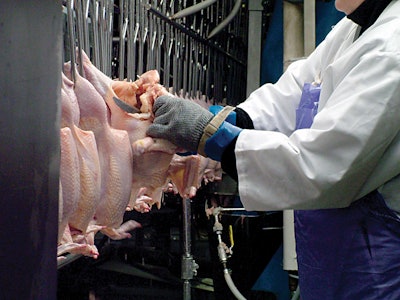
Retaining employees is a constant challenge for the poultry industry, but understanding why they leave or stay can help companies adjust their personnel approach and improve retention.
Matt Spencer, U.S. Poultry & Egg Association’s director of human resources and safety programs, said the industry group wanted to find a way to track what strategies companies are using to retain their employees and how successful they really were. In March 2018, the group surveyed 40 different locations around the country. Spencer shared the results on May 10 as part of the U.S. Poultry & Egg Association’s 2018 Poultry Processor Workshop in Orange Beach, Alabama.
High turnover rates
According to the survey, the average annual poultry employee turnover rate is 65 percent. Some locations said turnover was as low as 3.4 percent while others said it was as high as 150 percent. Comparatively, the national annual turnover rate for all manufacturing is 30.4 percent.
Spencer said when he examined just the poultry processors, the employee turnover was actually closer to 100 percent. Respondents said this turnover rate is affecting their company’s ability to operate.
Moreover, 58.1 percent of employees who are leaving are doing so after 90 days or fewer on the job. Few employees are sticking around much longer: 27.9 percent leave after more than 90 days but less than six months, and 14 percent leave after 6 months or more.
Motivations varied, but the top reasons for leaving were: the difficulty of the work; cold working conditions; issues with attendance and long working hours including six- to seven-day and 50- to 60-hour weeks. Secondary and tertiary reasons included: lack of transportation to work; lack of desire to keep the job; need for higher pay and moving away or out of the country.
Interviews and surveys to improve retention
The survey asked what kind of methods are used to encourage employees to stay at the company. A pair of questions centered on the concept of using employee surveys: exit interviews, and what it called stay interviews and engagement surveys.
Spencer received a variety of responses about exit interviews. Some interview those resigning with notice, others only interview skilled laborers, while others use outside firms to conduct exit interviews after resignation. Companies are trying to interview former employees, but it’s not consistent because ex-employees don’t want to be contacted or quit without notice.
As for stay interviews, he observed a similar inconsistency among the survey group. Those using stay interviews presented a range of answers, with some saying they survey all hourly and salaried employees while others said they only interview workers who presented issues to their human resources department. A large majority of the survey group said they did not conduct interviews or surveys examining why employees stay at the company.
For engagement surveys, several respondents said they did not use any surveys to find out what engages their employees. Those that do had a varied approach with some conducting regular surveys of all employees and some using outside firms to hold the interviews.
Those surveying employees said they believe the following practices are most effective in improving retention and reducing turnover: the stay interviews and engagement interviews; new-hire interviews held after three weeks or 45 days after hire and roundtable employee meetings. Some said they formed a team to focus on their turnover and employee survey results.
Accountability and supervisor training
The survey asked who’s ultimately accountable for turnover and retention issues. Respondents said: managers and supervisors, the human resources department, the president of the company, all salaried employees, everyone and no one.
“I have to say that we did get a lot of ‘no one is held accountable’ for it,” Spencer said.
Respondents said forms of accountability include quarterly and biannual goals for retention and department and corporate score cards.
The group was asked about what type of supervisor training programs they use to help improve retention. Answers varied widely, with some using proprietary training programs and others using internal methods like monthly training seminars, training for newly hired or transferred managers, computer-based training and soft-skill training tracks. Some said they do not train for this purpose.
A number of respondents do offer an incentive program for both rank-and-file workers and management related to employee retention. The programs includes: attendance bonuses, referral bonuses, perfect attendance bonuses, supervisor bonuses tied to no turnover and employee drawings for good attendance.
The final question on the survey asked: “What is the single most important factor you have found to improve retention?” Responses included: a positive work environment fostered by management; giving back to the employees; regular contact with new hire employees; temporary services that provide transportation for employees; 40- to 45-hour work week; Monday through Friday work week; direct communication; the direct supervisor taking the time to get to know employees; good benefits; mentoring programs and retention teams.

Most poultry employees are leaving after less than three months on the job, according to an industry survey. | Courtesy US Poultry & Egg Association
Communication helps retention
Based on the results of the survey, Spencer concluded communication between the supervisor and the employee is critical for turnover. His association is now working on a program to help train supervisors in more effective communication. It will include training on positive and negative forms of communication, how to conduct impactful job reviews with the workforce and better understanding financial management as a supervisor in the poultry industry.
Spencer said the objective of this training program is to empower new supervisors and give them the tools to both start-off on the right foot and effectively communicate with the workforce. Fostering an “open door” environment with the workers will hopefully help improve retention in the long term.
For now, Spencer recommended that companies that are conducting surveys or interviews with their employees make use of the data they collect. Companies should use it to develop employee retention strategies and inform their policies going forward.

















